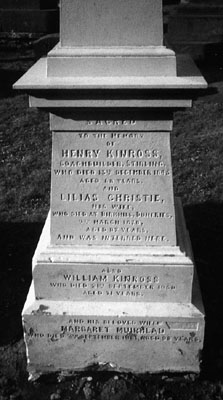

Henry Seymour Kinross was born at Kippenross, the son of William Kinross, a farmer at Kippenross, and Isabella Clow. He was baptised on 30th August 1778 in Dunblane and he died aged 68, at Stirling on 13th December 1845 and is buried there at The Church of The Holy Rude .
Henry Kinross founded the carriageworks with Mr William Croall, "formerly of Airthrey", at the head of Shore Road, Stirling. Henry had served an apprenticeship to Mr Croall.
Henry is recorded in the 1841 census of Stirling as a “Coach Builder” living in North Cowane Street next door to his older brother William Kinross who was a “Coach Maker Journeyman”. In 1845, Henry's burial record states that he was “of Viewfield Street”.
Admitted as Burgess, Stirling on 6th April 1816, occupation ‘hammerman’.
He married Lilias Christie on 19th October 1829 at Old Croft, St.Ninians, Stirling. Lilias was born in February 1791 at Old Croft Farm to John Christie, farmer, and Margaret Forman. Her uncle, James Forman, a bookseller, was the Provost of Stirling in 1832. She died, a widow, on 9th March 1878, aged 87, at Birkhill, Dumfries and is buried with Henry at The Church of the Holy Rude, Stirling. Their grave is on a plot belonging to, and next to, that of James Forman.
Henry and Lilias had a daughter Margaret, baptised 5th October 1831 in Stirling. In Henry's will of 1848, she is described as their only surviving child.
In December 1837 the Croall & Kinross Company was formerly dissolved and the works now passed to Henry Kinross as the sole partner.
Henry was appointed coachmaker for Scotland to Queen Victoria, with the Royal Warrant conveyed in letters by Lord Dalmeny in 1838.
"Queen Victoria and Prince Albert visited Stirling on 13th September 1842. On reaching the bridge at Stirling, the horses of the royal coach were changed, and the entourage was joined by several hundred men belonging to the local militia to escort Her Majesty through the town. At this point too, Henry Kinross, who was coachbuilder to the Queen, produced a huge timber platform on wheels which was capable of carrying 70 persons to join the escort. The Royal group was not scheduled to visit his workshop, so Mr. Kinross, always a razor-sharp entrepreneur, took the opportunity to pay his compliments to his most valued customers".
The National record of the visit of Queen Victoria to Scotland, 1842 records:
"When near the bridge the cortége stopped, and changed horses before entering the
town. Just at this spot a number of carriages were collected, and, among the rest, was a
large temporary machine, erected upon carriage-wheels, by Mr. Henry Kinross, Coachmaker to her
Majesty, whose place not being upon the line her Majesty would follow in passing through the town,
devised this sure mode of testifying his loyalty. It was a large structure, highly decorated
with evergreens, and ornamented with a Crown composed of dahlias and other flowers, and capable of
containing seventy people standing."
A newspaper report the following week attributes the following
decorations along the Royal route to Henry Kinross.
"Mr Kinross, Coachmaker to her Majesty. - An arch,
summounted by a crown, flags & c."
On 2nd January 1845 the Stirling Observer printed on the
front page.
"A list of the names and residences of the High Contsables of the
Burgh of Stirling. To serve as a matter of Reference to the Public, should anything
be wanted in the neighbourhood. Messrs... Henry Kinross, Coachmaker, Shore Road".
When he died, in 1845, he left the carriageworks to his nephew William Kinross, the son of his younger brother George.
The Stirling Observer, 18th December 1845, reported in the deaths
column on page 4:
"At Viewfield St., here on the 13th instant, Mr Henry Kinross, coach-builder,
aged 68. - Friends will please accept this intimation".
| To The Family Tree | Index | To William Kinross |